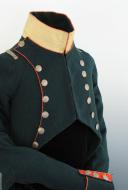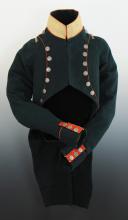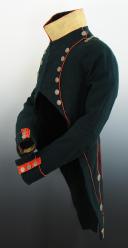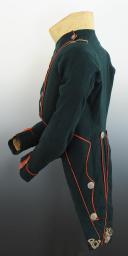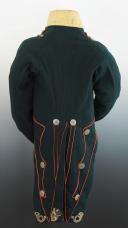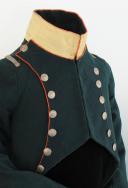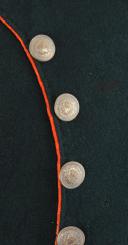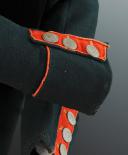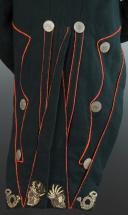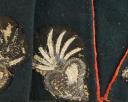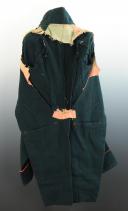
JUNIOR OFFICER'S UNIFORM, company of Voltigeurs, OF THE NATIONAL GUARD OF ISTRIA “Guardia Nazionale del Istria”, KINGDOM OF ITALY, FIRST EMPIRE 1807-1809. 27608
Sold out
JUNIOR OFFICER'S UNIFORM, company of Voltigeurs, OF THE NATIONAL GUARD OF ISTRIA “Guardia Nazionale del Istria”, KINGDOM OF ITALY, FIRST EMPIRE 1807-1809. 27608
Dark green cloth coat.
Release lapels on the pockets at the bottom, with three points at the top, in green cloth piped in scarlet, each is bordered with 7 small module uniform buttons in silver metal molded in relief of the Italian crown with branches of oak and laurel and surrounded by the inscription “GUARDIA NAZIONALE DEL L’ISTRIA” (diameter 1.9 cm). The right part of the uniform is decorated with 9 hooks and rings on the lapel and 4 at the collar. Facings in green cloth with scarlet piping, scarlet facing tabs with green piping garnished with 3 small module uniform buttons. False scarlet piped rear pockets forming 3 points each garnished with a large module uniform button (diameter 2.7 cm). Basque with scarlet piped green cloth cuff, the exterior corners of each basque are garnished with a hunting horn embroidered in silver threads and cannetilles (H 4 cm, width 5.7 cm), the two interior angles are embroidered with a heart surmounted by seven flames, embroidered in threads, cannetilles and silver sequins (H 6.1 cm, width 4.5 cm). Collar in scarlet piped daffodil cloth. Epaulette loops in silver braid woven in a “cul de dice” pattern (width 1 cm). Interior lining in green cloth and pink silk (largely missing).
Kingdom of Italy.
First Empire, (1807-1809).
Very good state of conservation with the exception of the silk double which is largely missing. This uniform belongs to an ephemeral corps, because the “Guardia Nazionale del Istria” of the Kingdom of Italy only lived for two and a half years.
this may explain the excellent state of conservation of the object.
NOTE :
The uniform in question presents dark green as a background color, which could recall both the uses of the first National Guards of the Cisalpine Republic; and the uses of Italian light corps, from the outfits of which this uniform is visibly inspired.
Indeed, if it were not for the button with the very explicit legend, and for the shape of the facings, one could almost think, when looking at this coat, that we are in the presence of an officer's outfit of one of the Italian light regiments!
To date we know very few uniforms of the Kingdom of Italy:
- uniform of Major General (probably of Viceroy Eugene), Historical Museum of Moscow.
- Honor Guard uniform at the Army Museum, Hôtel des Invalides in Paris, 1813-14.
- small uniform of the Guard of Honor, 1813-14, Museum of the City of Como.
- uniform of a junior officer of the Velites Grenadiers of the Royal Guard, Bologna Museum.
- non-commissioned officer uniform of the Velites Grenadiers of the Royal Guard, from the former Fausto Foroni collection in Milan, on sale at Hermann Historica in 2011.
- uniform probably of non-commissioned adjutant of the Dragoons of the Royal Guard from the French private collection.
- adjutant-commander's uniform in full dress (in dark green cloth), from the former Fausto Foroni collection in Milan, on sale at Hermann Historica in 2011, cut from 1805 with first Italian button stamped with the lion of Saint Mark ( scarlet collar and cuffs).
- adjutant-commander's campaign dress uniform that belonged to de Cavedoni (in dark green cloth), collection of the Modena Museum in Italy.
- aide-de-Camp uniform of His Imperial Highness Eugène de BEAUHARNAIS (modeled on the adjutant-commander's full dress uniform) of General Auguste Sorbier (1773-1809), General of the Empire, General in Chief of the Army of the Viceroy of Italy, Italian Ambassador to the Grande Porte, Bertrand Malvaux collection.
- uniform of junior officer, Voltigeurs company, of the Istrian National Guard “Guardia Nazionale dell’Istria”, Kingdom of Italy, First Empire 1807-1809.
- officer uniform of the 3rd line infantry regiment, First Empire.
HISTORY:
This uniform belongs to an ephemeral corps, because the “Guardia Nazionale del Istria” of the Kingdom of Italy only lived for two and a half years.
It was established in June 1807 by decree of Viceroy Eugene, so as to replace the old territorial or militia units of the Republic of Venice, the "Cernides" and the "Bombardieri".
The first commander of the National Guard thus established was Count Barnaba Bruti, of Capo d'Istria (now Koper in Croatian), capital of the Istrian peninsula as well as of the new barely conquered department. Prefect Calafati then organized two companies in Capo d'Istria itself.
This period also corresponds to the phase of general reorganization of National Guard units throughout the Kingdom of Italy through its 31 municipalities.
By royal decree n.23 of February 15, 1809, Mr. Michele Totto was subsequently appointed commander of the National Guard of Capo d'Istria.
During the temporary return of the Austrians to Istria, between April 14 and May 23, 1809, these companies were abolished, but then reestablished so as to support the action of the Italian troops during the campaign of 1809, with particular effort during the operations of August and October 1809 against pro-Austrian insurgents, which earned them the official praise of the Kingdom's Ministry of the Interior. The units thus mobilized were treated, according to French usage, on the administrative basis of army units, whether they were in marching battalions or garrison battalions on the coasts.
At the same time, a company of Coast Guard Gunners was also established by bringing in men from the GN units of the maritime communes (this implied the service of fairly robust batteries, like that of Pula equipped with 50 artillery pieces)
The GN was also used to support the gendarmerie, notably in sweeps against the brigands who infested the areas of Dignano (now Vodnjan in Croatia) and Pola (now Pula).
In 1810, with the passage of ex-Venetian Istria and ex-Austrian Istria to the Lyric Provinces of the French Empire, the GN of Istria ceased to be an Italian unit.
Marmont in fact established an “Istrian National Guard” (“Guardia Nazionale Istriana”) but the latter, unlike the Italian one, was a territorial militia, and not a civic guard.
We do not have any documentary information on the structural organization of this short-lived National Guard.
The very existence of "acrobat" companies (which the attributes of the rolled-up sides of this coat as well as the shape of the lapels and the yellow color at the collar seem to demonstrate in a resounding manner) cannot be validated on a historical level.
BIBLIOGRAPHY:
- Bollettino delle Leggi del Regno d’Italia, 1809
- Storia Militare del Regno Italico, volume II “Il dominio dell’Adriatico”, parte II cap. 9
THANKS :
I thank Massimo FIORENTINO who agreed to do historical research on this body.
Dark green cloth coat.
Release lapels on the pockets at the bottom, with three points at the top, in green cloth piped in scarlet, each is bordered with 7 small module uniform buttons in silver metal molded in relief of the Italian crown with branches of oak and laurel and surrounded by the inscription “GUARDIA NAZIONALE DEL L’ISTRIA” (diameter 1.9 cm). The right part of the uniform is decorated with 9 hooks and rings on the lapel and 4 at the collar. Facings in green cloth with scarlet piping, scarlet facing tabs with green piping garnished with 3 small module uniform buttons. False scarlet piped rear pockets forming 3 points each garnished with a large module uniform button (diameter 2.7 cm). Basque with scarlet piped green cloth cuff, the exterior corners of each basque are garnished with a hunting horn embroidered in silver threads and cannetilles (H 4 cm, width 5.7 cm), the two interior angles are embroidered with a heart surmounted by seven flames, embroidered in threads, cannetilles and silver sequins (H 6.1 cm, width 4.5 cm). Collar in scarlet piped daffodil cloth. Epaulette loops in silver braid woven in a “cul de dice” pattern (width 1 cm). Interior lining in green cloth and pink silk (largely missing).
Kingdom of Italy.
First Empire, (1807-1809).
Very good state of conservation with the exception of the silk double which is largely missing. This uniform belongs to an ephemeral corps, because the “Guardia Nazionale del Istria” of the Kingdom of Italy only lived for two and a half years.
this may explain the excellent state of conservation of the object.
NOTE :
The uniform in question presents dark green as a background color, which could recall both the uses of the first National Guards of the Cisalpine Republic; and the uses of Italian light corps, from the outfits of which this uniform is visibly inspired.
Indeed, if it were not for the button with the very explicit legend, and for the shape of the facings, one could almost think, when looking at this coat, that we are in the presence of an officer's outfit of one of the Italian light regiments!
To date we know very few uniforms of the Kingdom of Italy:
- uniform of Major General (probably of Viceroy Eugene), Historical Museum of Moscow.
- Honor Guard uniform at the Army Museum, Hôtel des Invalides in Paris, 1813-14.
- small uniform of the Guard of Honor, 1813-14, Museum of the City of Como.
- uniform of a junior officer of the Velites Grenadiers of the Royal Guard, Bologna Museum.
- non-commissioned officer uniform of the Velites Grenadiers of the Royal Guard, from the former Fausto Foroni collection in Milan, on sale at Hermann Historica in 2011.
- uniform probably of non-commissioned adjutant of the Dragoons of the Royal Guard from the French private collection.
- adjutant-commander's uniform in full dress (in dark green cloth), from the former Fausto Foroni collection in Milan, on sale at Hermann Historica in 2011, cut from 1805 with first Italian button stamped with the lion of Saint Mark ( scarlet collar and cuffs).
- adjutant-commander's campaign dress uniform that belonged to de Cavedoni (in dark green cloth), collection of the Modena Museum in Italy.
- aide-de-Camp uniform of His Imperial Highness Eugène de BEAUHARNAIS (modeled on the adjutant-commander's full dress uniform) of General Auguste Sorbier (1773-1809), General of the Empire, General in Chief of the Army of the Viceroy of Italy, Italian Ambassador to the Grande Porte, Bertrand Malvaux collection.
- uniform of junior officer, Voltigeurs company, of the Istrian National Guard “Guardia Nazionale dell’Istria”, Kingdom of Italy, First Empire 1807-1809.
- officer uniform of the 3rd line infantry regiment, First Empire.
HISTORY:
This uniform belongs to an ephemeral corps, because the “Guardia Nazionale del Istria” of the Kingdom of Italy only lived for two and a half years.
It was established in June 1807 by decree of Viceroy Eugene, so as to replace the old territorial or militia units of the Republic of Venice, the "Cernides" and the "Bombardieri".
The first commander of the National Guard thus established was Count Barnaba Bruti, of Capo d'Istria (now Koper in Croatian), capital of the Istrian peninsula as well as of the new barely conquered department. Prefect Calafati then organized two companies in Capo d'Istria itself.
This period also corresponds to the phase of general reorganization of National Guard units throughout the Kingdom of Italy through its 31 municipalities.
By royal decree n.23 of February 15, 1809, Mr. Michele Totto was subsequently appointed commander of the National Guard of Capo d'Istria.
During the temporary return of the Austrians to Istria, between April 14 and May 23, 1809, these companies were abolished, but then reestablished so as to support the action of the Italian troops during the campaign of 1809, with particular effort during the operations of August and October 1809 against pro-Austrian insurgents, which earned them the official praise of the Kingdom's Ministry of the Interior. The units thus mobilized were treated, according to French usage, on the administrative basis of army units, whether they were in marching battalions or garrison battalions on the coasts.
At the same time, a company of Coast Guard Gunners was also established by bringing in men from the GN units of the maritime communes (this implied the service of fairly robust batteries, like that of Pula equipped with 50 artillery pieces)
The GN was also used to support the gendarmerie, notably in sweeps against the brigands who infested the areas of Dignano (now Vodnjan in Croatia) and Pola (now Pula).
In 1810, with the passage of ex-Venetian Istria and ex-Austrian Istria to the Lyric Provinces of the French Empire, the GN of Istria ceased to be an Italian unit.
Marmont in fact established an “Istrian National Guard” (“Guardia Nazionale Istriana”) but the latter, unlike the Italian one, was a territorial militia, and not a civic guard.
We do not have any documentary information on the structural organization of this short-lived National Guard.
The very existence of "acrobat" companies (which the attributes of the rolled-up sides of this coat as well as the shape of the lapels and the yellow color at the collar seem to demonstrate in a resounding manner) cannot be validated on a historical level.
BIBLIOGRAPHY:
- Bollettino delle Leggi del Regno d’Italia, 1809
- Storia Militare del Regno Italico, volume II “Il dominio dell’Adriatico”, parte II cap. 9
THANKS :
I thank Massimo FIORENTINO who agreed to do historical research on this body.
Reference :
27608
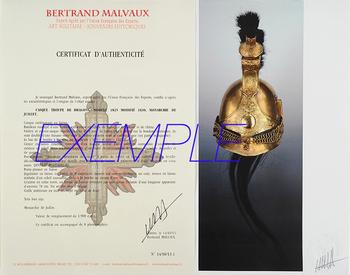
Next update Friday, april 4th at 1:30 PM
FOR ALL PURCHASES, PAYMENT IN MULTIPLE CHECKS POSSIBLE
bertrand.malvaux@wanadoo.fr 06 07 75 74 63
An authenticity certificate of the item including the description published on the site, the period, the sale price, accompanied by one or more color photographs is automatically provided for any item priced over 130 euros. Below this price, each certificate is charged 5 euros.
Only items sold by me are subject to an authenticity certificate, I do not provide any expert reports for items sold by third parties (colleagues or collectors).
